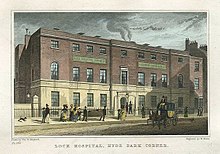Lock hospital

A lock hospital was an establishment that specialised in treating sexually transmitted diseases. They operated in Britain and its colonies and territories from the 18th century to the 20th.[1]
History[]
The military had a close association with a number of the hospitals. By the mid-19th century most of the larger army bases in India were home to a lock hospital.[2] There were more military than civil lock hospitals in India, due to the prevalence of venereal diseases amongst British troops.[3] In 1858 the Admiralty paid to have one opened in Portsmouth and in 1863 another in Plymouth.[4]
The earliest lock hospitals in India were established around 1797 at Berhampur, Kanpur, Danapur, and Fatehgarh. They were usually within bazaars, surrounded by a mud wall and staffed by a doctor and a female nurse. The local police were in charge of rounding up women suspected of being diseased, who could return home only after obtaining a certificate of discharge.[5]
Lock Hospital operated in Hong Kong from 1858 to 1894 to deal with venereal diseases.
The term "lock hospital" originates from their use as leprosariums, in which the patients were kept in restraints.[1]: 3
See also[]
- London Lock Hospital
- Westmoreland Lock Hospital, Dublin
- Contagious Diseases Acts
- Glasgow Lock Hospital
References[]
- ^ a b Loundes, Frederick W. (1882). Lock Hospitals and Lock Wards in General Hospitals. London: J. & A. Churchill.
- ^ Dartnell, George R. (1860). "On the prevalence and severity of syphilis in the British army and its prevention". British Medical Journal. 1 (174): 317–319. doi:10.1136/bmj.s4-1.174.317. PMC 2252720.
- ^ Sehrawat, Samiksha. "Institutions: Lock hospitals: Measures to halt venereal diseases". Medical History of British India. National Library of Scotland. Retrieved 24 October 2013.
- ^ Stark, Suzanne J. (1998). Female Tars: Women aboard ship in the age of sail. Pimlico. p. 33. ISBN 978-0-7126-6660-2.
- ^ Wald, Erica (5 May 2009). "From begums and bibis to abandoned females and idle women". The Indian Economic & Social History Review. 46 (1): 5–25. doi:10.1177/001946460804600102. S2CID 143874173.
External links[]
- Hospitals by medical condition
- Sexual health
- History of the British Empire
- Women's health in the United Kingdom